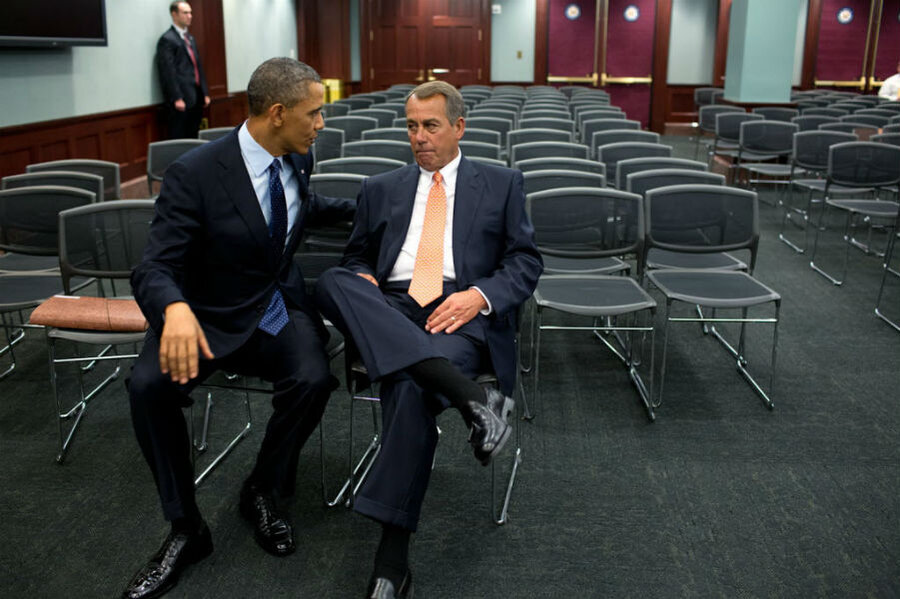Partisan America: Divisions deepen in politics, daily life, Pew study finds
Loading...
So many pundits have lamented the polarization of America’s political climate that doing so seems a cliché. But on Thursday, the Pew Research Center released a report indicating that partisanship today is even more pervasive and deeply entrenched than commonly supposed.
Americans have, over the past two decades, hewed to party orthodoxies more than at any other time in recent history, according to the report, which sampled the opinions of thousands of respondents nationwide in 1994, 2004, and 2014.
This rise in partisanship has gone hand in hand with rising distrust between Democrats and Republicans – and an increasingly insular atmosphere within the two camps, the Pew report found.
“Republicans and Democrats are more divided along ideological lines – and partisan acrimony is deeper and more extensive – than at any point in recent memory,” reads the report. “And these trends manifest themselves in myriad ways, both in politics and everyday life.”
In terms of policy, the portion of Americans who toe a “consistently liberal” or “consistently conservative” line has more than doubled, from 10 percent to 21 percent, since 1994. Among those who are “politically engaged,” this number has soared from 8 percent to 38 percent among Democrats, and jumped from 23 percent to 33 percent among Republicans.
Just as the number of diehard partisans has risen, the number of moderates has decreased, the Pew report found. Ten years ago, 12 percent of Democrats were more conservative than the average Republican, and 16 percent of Republicans were to the left of the median Democrat. Today, these numbers have shrunk to 1 percent and 2 percent respectively.
This is a reality reflected in Congress: Currently, the report says, no Republicans in the House or Senate are more liberal than the most conservative Democrat, nor are any Democrats more conservative than the most liberal Republican. Twenty years ago, 12 legislators occupied this middle ground.
As this ideological orthodoxy has increased, so to has distrust between the parties. Over the past two decades, the proportion of Republicans with “very unfavorable” views of the opposing party has risen from 17 percent to 43 percent. Among Democrats, this number has risen from 16 to 38 percent.
“There’s an intense feeling among active partisans that the other party represents a threat,” said Carroll Doherty, director of political research at the Pew Research Center. “It’s a minority of Americans that feel this negatively about the opposing party. But it’s difficult to find compromise among people who think that the other party represents a threat to the nation’s wellbeing.”
Politics isn't the only point of disagreement, Mr. Doherty points out. According to the study, the two groups also diverge when it comes to basic lifestyle choices – including the types of friends they associate with and the kinds of people they would marry.
Among the most salient lifestyle divides was that between the kinds of communities considered desirable by the two groups.
“It’s an enduring stereotype – conservatives prefer suburban McMansions while liberals like urban enclaves – but one that is grounded in reality,” reads the report. “Given the choice, three-quarters (75%) of consistent conservatives say they would opt to live in a community where ‘the houses are larger and farther apart, but schools, stores and restaurants are several miles away,’ and just 22% say they’d choose to live where ‘the houses are smaller and closer to each other, but schools, stores and restaurants are within walking distance.’ ” Among consistent liberals, these numbers were reversed, with 77 percent preferring the latter arrangement and 22 percent preferring the former.
“It’s hard to say why this is,” says Doherty. “But there may be a sense among conservatives that this is your property, this is a place of your own, and you value that separateness.”
For conservatives: Another deciding communal factor was religion, with 57 percent saying it was important that many members of their faith lived nearby. For liberals, only 17 percent said they considered this important.
“I think the big the takeaway from all of this is the separateness that we all have,” says Carroll. “It extends to our lifestyles now. Clearly, there are big differences in what conservatives and liberals are looking for in life.”





